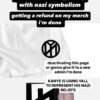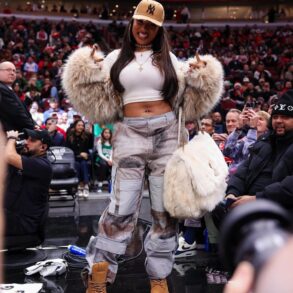Clare Waight Keller: ‘Working in luxury can be magical, but the idea you’re helping millions of people to find something that makes them feel good is really thrilling’
Credit: Trisha Ward
Remember when high-street designer collaborations were more abundant than Harry Styles’ costume changes? We’ve probably all lost count of the duds that turned out to be a quick-fix marketing ploy rather than an exercise in creating something with longevity.
The poorly executed collabs have thinned out dramatically over the past few years. The ones left have given us some bona-fide classics. Anyone who invested in Jil Sander’s stylish quilted coats, double-faced jackets or knitted shirts for Uniqlo under the +J label, for example, or bought the stripy knit dresses and liner coat from Collagerie’s recent hook-ups with Jigsaw (pricey for the high street but worth it for the high-end finishes), or regularly dives into JW Anderson’s and Inès de la Fressange’s ongoing ranges for Uniqlo (the Japanese behemoth has form for famous collaborators) is very likely to be still wearing those pieces.
Well, get ready: there’s another gem on the way. Whether your tastes run to knitwear or coats, feminine skirts or tailored androgyny, you should find them in designer Clare Waight Keller’s Uniqlo collection, Uniqlo : C, which lands in stores and online on Friday, September 15.
In 41 items (including four styles of footwear, two hats, two scarves, one bag) and a big old handful of colours, such as black, cream, taupe, sherbet lemon, blush pink, ginger, brick and chocolate brown, Waight Keller has created a capsule collection of versatile, sophisticated pieces that make sleek and polished dressing accessible to all of us.


Waight Keller’s Uniqlo collaboration reflects how she and her friends want to dress now
Credit: Trisha Ward
Then again, this is the same Waight Keller who, although not a household name, has one of the best CVs in luxury fashion. If she can’t orchestrate a decent high-street collection, who can?
She began at Calvin Klein in the ’90s when he was still in charge and the label was one big fluffy cloud of cashmere and bias-cut silk. She then worked her way through stints at Ralph Lauren and Gucci, under Tom Ford. Her first role as artistic director came in 2005 at Pringle of Scotland, where she oversaw an acclaimed rebrand of the heritage knitwear label.
From 2011, it was Waight Keller who revived Chloé when several previous designers had tried and failed following Phoebe Philo’s departure in 2006. After a hugely successful run there, in 2017 she was appointed artistic director of Givenchy, one of the few Parisian houses still creating couture, to rave reviews. There’s more.
The dark horse who surprised everyone when she stepped out of the shadows of St George’s Windsor and began arranging the-then Meghan Markle’s wedding dress train? That was her.


Clare took her opportunity to make last-second adjustments to Meghan’s dress
Credit: BEN STANSALL/AFP via Getty Images
And now, after radio silence for three years – she left Givenchy ‘by mutual agreement’ in 2020 – the 53-year-old designer is sitting opposite me over breakfast on one of those muggy, blazing hot then rainy days that marked this summer in London.
Having won Designer of the Year at the British Fashion Awards in 2018, Waight Keller’s abrupt departure from Givenchy took everyone by surprise. ‘I’m still on very good terms with LVMH [which owns Givenchy],’ she says. So she wasn’t exactly desperate to rush into her next gig. She spent a lot of time at her house in Cornwall, enjoying time with her three children (twin daughters, now 20, and a son, now 12), digesting the newfound objectivity her distance from the industry brought. ‘You end up in such a bubble when you design for a luxury brand, and you don’t even necessarily realise it. You’re really not tasked with thinking about what the client needs so much as creating an artistic architecture for the brand.’
The Uniqlo call came 18 months ago. Although she’s never been a big high-street shopper, preferring vintage, she shops at Uniqlo – the men’s cashmere particularly. It’s an intriguing alliance. Uniqlo is known for its quilted outerwear, innovative heat tech, excellent-value cashmere and a no-frills, androgynous aesthetic. Waight Keller, on the other hand, first made her name as a standalone designer (at Pringle) with ultra-feminine clothes.
At Chloé, she gradually introduced rigorously sharp blazers and masculine trousers into the mix of ruffled blouses and boho dresses, but it was never a place for minimalism. ‘I think the contrast is one of the things that attracted Uniqlo to me. They want to broaden their offer’.


Waight Keller revived Chloé when several previous designers had tried
Credit: PATRICK KOVARIK/AFP via Getty Images
There are three key factors in a great designer/high-street collection: fabric, fabric and fabric. You can have all the clever design in the world, but if the fabrics don’t enable the designer to see their vision through, the designer feels as though they’re slumming it and invariably that disenchantment shows in the final product. And Waight Keller knows fabric. She has only ever worked high-end until now. At each house, she got to handle the best raw materials.
One of the big draws for Waight Keller was Uniqlo’s track record with Jil Sander. ‘I loved the way she was allowed to really harness all Uniqlo’s technical innovation and performance fabrics, and make it feel luxurious. Two decades ago, the high street wasn’t great for women my age looking for clothes to wear to work. But that’s changed. When Uniqlo started working with Jil back in around 2009, I thought, “This is interesting – they’re not just about a quick win, but making clothes with authentic longevity.”’
She says she hasn’t had to compromise much on fabrics and quality. ‘There was one particular silk I couldn’t use because it would have pushed the blouses out of Uniqlo’s price structure, but I think that was it. Uniqlo works with amazing mills – they’re some of the same ones I worked with when I was designing for those luxury European labels.’ She’s not claiming the fabrics are identical – mills generally have different grades depending on price. ‘But the differentiation between an expensive product and a high-street one isn’t always as great as you might imagine,’ she says.
Even so, expecting a £40 dress to offer the same qualities as a £1,400 one is delusional. But developing a discerning eye will help you work out whether you necessarily want or need what goes into the £1,400 dress – knowing when to splurge and when to zero in on a great-value budget buy is a skill worth cultivating. ‘Uniqlo’s cotton and linen shirts are amazing value,’ says Waight Keller. ‘That’s true right across their range, not just mine. Fine cotton can be very expensive, but they’ve utilised their size to get an economy of scale that delivers really well – and their product testing is second to none. Even the easy-care ones have a natural-looking finish.’


‘There’s a real yearning to declutter and focus on pieces that do a perfect job, whether they’re high street, second hand or designer’
Credit: Trisha Ward
Her own sartorial MO is discreet, sophisticated but low-key. Today she’s in a double-breasted navy blazer from her days at Chloé with her favourite peak lapels, which fits perfectly. She’s paired it with an old Chloé maxi-skirt, a high-street vest and some backless sandals she’s testing out for her second Uniqlo collection, which launches next spring. This is a big deal: Uniqlo has never done shoes before, but when Waight Keller explained how difficult it would be to create total looks without footwear, they doubled down on their commitment. This winter’s collection has three styles of boot and one of loafers, all in synthetic leather. There’s also a version of the famous nylon Round Mini Shoulder Bag, in a coated canvas. ‘I’ve bumped the size up a bit and made it so that you can wear it cross-body or hand-held’.
With her blend of carefully chosen high-street basics and classic, built-to-last separates, Waight Keller articulates a very sleek way to dress in a more sustainable way. She’s meticulous about looking after everything and defending her cache from the moths, which have been particularly virulent this year. ‘I’ve always loved clothes. I think they should be treated as if they’re precious.’ She uses hanging bags and MothOut (which you can buy on Amazon). ‘Use it in combination with lavender bags that you put inside cupboards, and place the traps outside in the room.’
It’s taken her a while to reach the perfect fashion equation for her: part tailored, part drapey skirts, and trousers in weights that work across seasons. The process made her all the keener to design investment pieces that won’t go out of style, as well as items that link everything together and the finishing touches that make it all seem current.
‘When I was able to look at my old wardrobe from my days of working at Givenchy with a dispassionate eye, there was quite a lot that didn’t seem relevant any more,’ she says. Some of it she got rid of, other pieces are part of her archive in her studio. The Uniqlo collaboration reflects how she and her friends want to dress now. ‘There’s a real yearning to declutter and focus on pieces that do a perfect job, whether they’re high street, second hand or designer.’
Her own wardrobe, she says, ‘is really tight now. I’ve probably got six blazers, including double and single breasted, in a tropical wool weight that means I can wear them pretty much year round; a handful of cashmere jumpers; more tops than I probably should; and eight pairs of trousers. Typically I have two pairs of jeans, two pairs of dress pants, two pairs of work trousers and two pairs of what I call “novelty trousers” – something with a really strong fashion point of view. Depending on the season, that might be very high-waisted, or very wide-legged.’ The latter are her statements – bold silhouettes that make her library of classics interesting. When she’s tired of the statements, she swaps them with two others from her archive rail, or goes shopping on eBay. ‘It’s my absolute favourite,’ she says. ‘Sometimes I see some of my old pieces for Givenchy on there, which is great. It’s really gratifying to see your work still in circulation.’
Like millions, her style of dressing changed during the pandemic. ‘I think everyone’s looking for those one or two special pieces that help you reinvent what you already have. And comfort has become a given’.
This brings us to the Duchess of Sussex and her Californian reinvention. Waight Keller is loyal and discreet. Although she hasn’t worked with the Duchess since the latter departed for the States, she notes: ‘She is much freer now to be herself and I think she’s done a great job of working out a new image.’
The fact that, amid all the fevered speculation about who was designing the wedding dress, Waight Keller’s name never came up is partly down to her perpetual self-effacement. But there’s another reason. She’s British – from Birmingham – but Givenchy is a French house and there was a general assumption that Meghan would opt for something entirely British as Kate Middleton had (her gown was designed by Sarah Burton at Alexander McQueen).
Waight Keller went on to design a number of outfits for Meghan during her time in the UK, including coats and cocktail gowns – and memorably a cream wool capelet dress that’s one of Waight Keller’s personal favourites. The design of that dress, which Meghan wore to a royal engagement with Queen Elizabeth in 2018, has proved hugely influential since – a development not lost on Waight Keller.


When she won Designer of the Year in 2018, it was Meghan that presented her with the award
Credit: Joe Maher/BFC
Whatever your views of Meghan’s style, in Givenchy she looked streamlined and seemed to be carving out her own distinctive look. ‘We worked together very closely,’ says Waight Keller, ‘constantly talking through details and accessories. I loved it – it wasn’t only building a relationship with someone, but evolving their personal style. It’s not easy for any woman entering the Royal family. They have to express their own point of view but also be extremely appropriate.’ The two are still in touch and it won’t be a big surprise if Meghan, in her new phase of dressing more relatably, appears in a few Clare Waight Keller for Uniqlo pieces.
Implausibly youthful in her 50s , Waight Keller still spends a lot of her time at the family home in Cornwall, talking to the Uniqlo design teams in Tokyo on Zoom. ‘I’m much more casual than I used to be,’ she says. ‘But I also love tailoring. When you put a strong-shouldered jacket on, it doesn’t matter how casual the rest of your outfit is – it looks more pulled together.’
Her first Uniqlo collection has a corduroy blazer and matching trousers. ‘I love it because it has a stiffness that means you don’t need lots of shoulder padding or structure, but it also gets softer. This one doesn’t have the ’70s vibe I’d have given it at Chloé – with big lapels – but it has that versatility, which makes it look functional or more glamorous, depending on what you wear it with’.
Her next collection for Uniqlo is almost done – and there will be more. This is a long-term project and she’s clearly reinvigorated by it. ‘Don’t get me wrong: working in luxury can be magical,’ she says. ‘But the idea you’re helping millions of people to find something that makes them feel good is really thrilling.’
Uniqlo : C by Clare Waight Keller is available in stores and online from Friday September 15
This post was originally published on this site be sure to check out more of their content.









